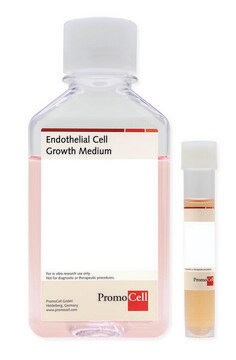300-05A
Human Coronary Artery Endothelial Cells: HCAEC, adult
Synonym(e):
HCAEC cells
About This Item
Empfohlene Produkte
Biologische Quelle
human coronary artery (normal)
Qualitätsniveau
Verpackung
pkg of 500,000 cells
Hersteller/Markenname
Cell Applications, Inc
Wachstumsmodus
Adherent
Karyotyp
2n = 46
Morphologie
Endothelial
Methode(n)
cell culture | mammalian: suitable
Relevante Krankheit(en)
cardiovascular diseases
Versandbedingung
dry ice
Lagertemp.
−196°C
Allgemeine Beschreibung
HCAEC provides an excellent model system to study all aspects of cardiovascular function and disease, and they have been utilized in dozens of research publications, for example to:
- Understand the mechanism of the anti-inflammatory properties of HDL, and demonstrate for the first time that mature miRNA can control gene expression in a cell where it is neither transcribed nor processed (Tabet, 2014)
- Study mechanisms of angiogenesis, as well as oxidative stress and inflammation related pathways in endothelia (Ji, 2009; Wang, 2011; Quinn, 2011; Hung, 2010; Rajesh, 2010; Riegel, 2011; Lin, 2013; Lloid, 2013Baley-Downs, 2012; Kapur, 2012; Melchior, 2012; Castanares-Zapatero, 2013; Hankins, 2013; Lord, 2013; dela Paz, 2013; Takai, 2013), including gender and race specific differences in patients with peripheral artery disease (Gardner, 2014)
- Elucidate molecular mechanisms of various cardiovascular risk factors, including those associated with diabetes (Vladik, 2011; Kapur, 2011; Dunn, 2013; Leucker, 2013; Liu, 2013, 2014; Morgan, 2014; Torella, 2014)
- Understand the mode of action and cardiovascular protection effects of various natural compounds, vitamins and drug candidates (Candelario, 2013; Ramirez-Sanchez, 2010, 2013; Lee, 2013; Nsimba, 2013; Di Bartolo, 2011; Baotic, 2013; Murphy, 2013; Tan, 2013; Wu, 2012), as well as caloric restriction (Csiszar, 2009, 2013)
- Develop and evaluate scaffolds and hydrogels for cardiac tissue engineering (Singelyn, 2009, 2011; Seif-Naraghi, 2010; Johnson, 2014), and new treatment strategies to prevent stent restenosis (O’Neill, 2009; O’Brien, 2010; Crowder, 2011, 2012; Eppihimer, 2013; Hiob, 2013)
- Compare effects of BMP-4 on HCAEC and Human Pulmonary Artery Endothelial Cells (HPAEC) and show that only in HCAEC BMP-4 treatment induced ROS, activated NF-kB, ICAM-1 and increased monocyte adhesiveness, explaining why its upregulation leads to atherosclerosis and hypertension in the systemic, but not pulmonary circulation (Csiszar, 2008)
Additionally, HCAEC, along with human aortic (HAOEC), carotid artery (HCtAEC), subclavian artery (HScAEC) and brachiocephalic artery (HBcAEC) have been used to demonstrate that not only blood vessels from different tissues are highly heterogeneous, they also interact differently with leukocytes during the inflammation response (Scott, 2013). The authors further showed that differential N-glycosylation of commonly expressed vascular adhesion molecules may be responsible for this heterogeneity, as well as for modulation of signaling under resting and activated inflammatory conditions. This also explains why specific vascular beds may be more or less susceptible to particular diseases or stimuli. Importantly, if cells from different sources were used, these results could not be convincingly validated due to a number of uncontrolled variables, such as age, race, genetic variability or life style choices of the donors.
Because of the complex heterogeneity that exists not only between different donors, but even between different vascular beds in the same individual, it would be prudent to confirm any new findings on primary cell lots coming from several different origins.
Ursprung der Zelllinie
Anwendung
Komponenten
Angaben zur Herstellung
- 2nd passage, >500,000 cells in Basal Medium containing 10% FBS & 10% DMSO
- Can be cultured at least 15 doublings
Subkultur-Routine
Haftungsausschluss
Lagerklassenschlüssel
10 - Combustible liquids
WGK
WGK 3
Flammpunkt (°F)
Not applicable
Flammpunkt (°C)
Not applicable
Zulassungslistungen
Zulassungslistungen werden hauptsächlich für chemische Produkte erstellt. Für nicht-chemische Produkte können hier nur begrenzte Angaben gemacht werden. Kein Eintrag bedeutet, dass keine der Komponenten gelistet ist. Es liegt in der Verantwortung des Benutzers, die sichere und legale Verwendung des Produkts zu gewährleisten.
EU REACH Annex XVII (Restriction List)
Hier finden Sie alle aktuellen Versionen:
Analysenzertifikate (COA)
It looks like we've run into a problem, but you can still download Certificates of Analysis from our Dokumente section.
Wenn Sie Hilfe benötigen, wenden Sie sich bitte an Kundensupport
Besitzen Sie dieses Produkt bereits?
In der Dokumentenbibliothek finden Sie die Dokumentation zu den Produkten, die Sie kürzlich erworben haben.
Protokolle
Store the cryovials in a liquid nitrogen storage tank immediately upon arrival.
Unser Team von Wissenschaftlern verfügt über Erfahrung in allen Forschungsbereichen einschließlich Life Science, Materialwissenschaften, chemischer Synthese, Chromatographie, Analytik und vielen mehr..
Setzen Sie sich mit dem technischen Dienst in Verbindung.




